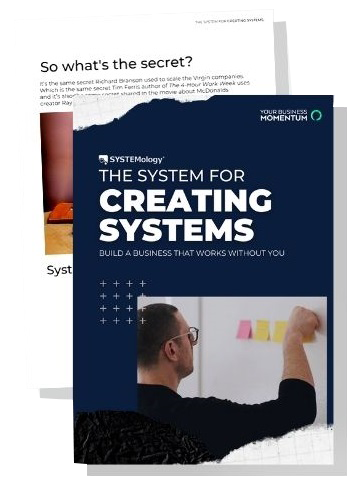How to document business processes and systems

Business processes and systems are the backbone and foundation of successful businesses. By documenting processes and systems in your business, it helps you to improve your business performance, creates consistency and ensures that any employee can step in and complete the work that is required.
In this blog, you’ll learn:
- Why should you document your business systems and processes
- Ways your business can benefit from documented processes and systems
- Why are business owners the worst person to document business processes
- Best practices for documenting your business systems and processes
- 4 quick steps to start documenting your business processes and systems
It’s ideal to set up processes and systems early on in your business journey, but it’s never too late, even if you’ve been in business for a long time. If you’re going through a growth phase in your business, or looking to scale up, having fully documented business processes and systems will make the process more streamlined, efficient and stress free.
Why should you document your business systems and processes?
Documenting your business systems and processes has the potential to provide many advantages to your business. It may feel like you need to spend a significant amount of time to put systems and processes in place, and that it is simply another distraction and needless waste of your time. Instead of focusing on how long it will take to set up and document your processes and systems, consider it as an investment in your business. If you want to grow your business, create more profit, or hire additional employees, then invest the time in completing this task and put your business in a great position to move forward, innovate and grow.

Ways your business can benefit from documented processes and systems
Using systems and processes in your business requires an investment in time, but it certainly will help your business to function more effectively, improve efficiency and help you make more money.
Getting your business processes and systems documented also releases you from the day-to-day operations of your business, and provides you with more freedom to work “on” your business, rather than “in” it.
Your business can benefit from documented processes, systems and procedures in a number of additional ways including:
- Creates consistency in the performance of tasks
- Provides employees with confidence to handle assigned tasks
- Reduces operational risks in regulated industries
- Allows for efficient training of new employees
- Assists in tracking particular key performance indicators (KPIs)
- Provides a foundation for continuous improvement
- Assists in reducing inefficiencies
- Allows employees to fill in for other team members when required
- Improves customer satisfaction due to consistent results and outcomes
- Allows business owners to plan ahead with confidence
Do you think your business is systemised? Click here and take this free 2-min Systems Strength Test to find out!
Documenting business systems and processes: why go it alone?
You might even intuitively know that business systems are the answer to many of your troubles, but, you ask yourself -- “How am I going to find the time to document everything I'm doing, and create systems, when I barely have the time to drink my coffee before it goes cold?”

When you first start out in business, everything revolves around you, the owner. You’re involved in every aspect of the business, from doing the day-to-day work, finances, marketing, HR, it all comes down to you. As the business grows, without processes and systems in place, there will be a bottleneck, which will hold your business back if you continue to be needed to be involved in every area of the business.
Two things will happen if that bottleneck is not resolved:
1) You, the owner, will become overwhelmed.
2) Your team will become frustrated.
When it comes to systemising businesses, there’s a common misconception out there that it has to be the business owner who has to create all the systems, because only you know how you want things done.
One of the issues or potential problems with this way of thinking is that everyone knows business systems are important, but unfortunately they never feel urgent. As a result, like all the ‘non-urgent’ tasks within your business, no one ever gets around to doing them.
And surprisingly, the truth is, the business owner is typically the WORST person to be documenting systems. However, this is good news for just about every small business owner on the planet. You no doubt have plenty of knowledgeable people who work with you in your team, or around you, and they might (at the very least) be able to start the process of documenting your business systems for you.
And the best news is, you don't have to create the systems yourself - keep reading and we’ll give you a guide that enables your team to do it for you.
Best practices for documenting your business systems and processes
When it comes time to document your business processes, there are a number of best practices you should follow. This will help to ensure that your investment in creating your systems, processes and procedures is highly beneficial to your business.
Consider timing
Documenting your business processes and systems will take some of your employees away from their core jobs into sessions where they extract the information needed for each of the processes or systems. Given this, it is recommended to plan ahead and choose the quieter months that your business experiences each year as an opportunity to kick-start your project. If you don’t have a ‘quiet period’, you can work the extraction sessions into regular meetings and break down your process documentation into smaller steps. This will still create awareness and your employees will see the impact and benefit of documenting the processes over time.

Involve key task owners and stakeholders
It’s important to involve key people in your team who complete the relevant tasks when documenting the process and extracting the necessary information. As part of the documenting process, you should interview employees who are using the systems and completing the tasks, to ensure you have a clear view of how the process runs. This will also assist in identifying any areas of concern or where exceptions might occur when the task is completed by different team members within the business.
Make process documents easily accessible
Easy access to your process documents is key to ensuring buy-in from your team and that systems and processes are accurately followed. If there are no sensitive trade secrets involved, by providing easy access to your employees, irrespective of whether they are involved in each particular process or not, will create a feeling of being valued. It will also allow them to gain an understanding of how each of the processes are interconnected within the business, which ultimately is beneficial to the entire team, and business.
Ensure flexibility is built into the system
Continual change and improvement is necessary as part of any business processes. To allow for any potential change, you must ensure that flexibility is built into the system. A process flow that made sense six months ago may quickly become outdated and not provide the desired outcome in the future.
Despite the need for flexibility, it’s important to note that making changes in print documents can be extremely difficult, or become messy, as all printed copies would need to be located and replaced with the current version.
Therefore, best practice is for all your process documents to be digitally based and accessible, be it as a shared folder in Google Drive, Dropbox or through a purpose-built software system. It’s also important that the process document includes a way that users are able to suggest improvements or notify the creators of any potential bottlenecks.
How to start documenting your business processes and systems
Once you’ve decided to commit to documenting your business processes and systems, you need to learn how to do it. Here are 4 steps to help you get started.
Step 1. Identify the minimum number of processes that, when systemised, will have the biggest impact on your business and your daily operations. It is recommended that you identify no more than fifteen processes to start.
Step 2. Create a system that outlines the steps for documenting your systems and procedures - your "system for creating systems”. Check out our guide below for the step-by-step process to create systems consistently and without needing the business owner to be involved.
Step 3. Find a systems champion on your team who can drive this initiative - preferably NOT the business owner. Empower this team member to oversee things and ensure your systems follow a uniform, organised and sensible structure.
Step 4. Stick with it until you document all the critical processes identified in step one, then rinse and repeat.
A guide to documenting your business processes and systems
So here's a question for you: can your business survive without you being involved in its daily operations?
Like many business owners, if you’re always busy working in the business, then taking the initial time needed to work on your business and document your processes and standard operating procedures might seem impossible.
If you feel like you don’t have the time to document your business processes, yet understand how important it is to the future growth of your business, and the benefits it will provide to your business in the long term, then it might be time to reach out for help.
You are welcome to download our practical guide on a ‘System for Creating Systems’, that you and your team can use to document, organise and optimise how your business does things.
The real magic of this guide? It is a system that takes you as the business owner completely out of the loop! It’s a complete, step-by-step approach that details how you can create systems consistently without you needing to be directly involved.
Download the free guide on The System for Creating Systems below.
The System For Creating Systems

Running a business can feel overwhelming, but it doesn’t
have to be.
Related Blogs

New year business planning

Not Sure If Feet First Is For You?
